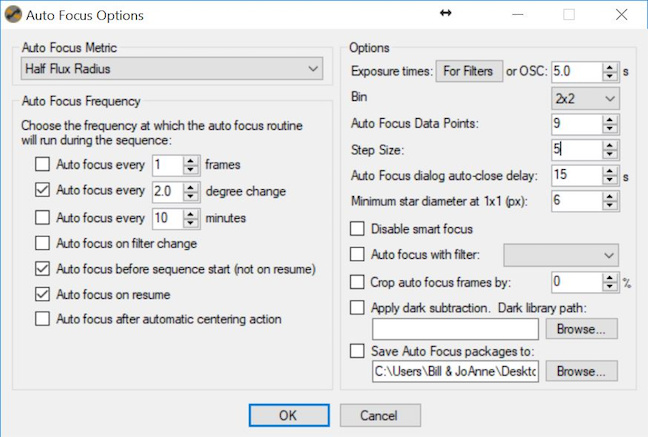Hi all. New to the forum but have been using SGP for the last year or so. I’ve tried off and on to get the auto focus to work as well as other features, but have hit the wall on a couple so hoping that the members can help me out. I have read the SGP manual and the SGP - The First Week countless times but still have some problems.
First, my setup and settings for auto focus.
Takahashi FSQ-130ED, Rigel nSTEP stepper focuser and a QHY367C OSC camera mounted on a CGE Pro.
Rigel focuser max position = 11600, max increment 999, temperature sensor for telescope
QHY367C has only 1x1 binning
Here are my Focus Control settings:
SGP Focus Control and Auto Focus Options.JPGManually focused with Bahtinov achieved at 3650 steps
Following the Setup steps: (without Bahtinov mask)
HFR was 2.99 with 75 stars.
Current Position 3520
After Frame and Focus trying for 3-5 times HFR, I could only reach 6.19 HFR.
The Step Size equation gave me a step size of 60. When I tried this, running the Focus Control, resulted in a huge movement of the focuser and a graph that looked nowhere close to a “V”. In addition the Rigel focuser did not like that setting at all. Sounded like gear slip, but that was not the case. I changed the step size to 26, it was better, but the curve was still not a V or U shape.
Compared with the examples in the manual, the HFR seem awful high. I must be missing some adjustment to bring that number down.
Since I was hoping to image on M81/M82 when I looked at the HFR calculation I notice that M82 was being ID’d as a star.
By then I hit the wall and had to call it a night. I went ahead and let the sequence run wondering what the focuser would do, but by then the overnight temp had stabilized and no other focus routines ran.
Any help or suggestions would be greatly appreciated.
Bill

